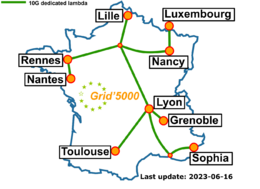Grid5000:Home
|
Grid'5000 is a precursor infrastructure of SLICES-RI, Scientific Large Scale Infrastructure for Computing/Communication Experimental Studies.
|
|
Grid'5000 is a large-scale and flexible testbed for experiment-driven research in all areas of computer science, with a focus on parallel and distributed computing, including Cloud, HPC, Big Data and AI. Key features:
Older documents:
|
Random pick of publications
Five random publications that benefited from Grid'5000 (at least 2925 overall):
- Quentin Guilloteau, Florina M Ciorba, Millian Poquet, Dorian Goepp, Olivier Richard. Longevity of Artifacts in Leading Parallel and Distributed Systems Conferences: a Review of the State of the Practice in 2023. REP 2024 - ACM Conference on Reproducibility and Replicability, ACM, Jun 2024, Rennes, France. pp.1-14, 10.1145/3641525.3663631. hal-04562691 view on HAL pdf
- Jolyne Gatt, Maël Madon, Georges da Costa. Digital sufficiency behaviors to deal with intermittent energy sources in a data center. ICT4S 2024: International Conference on ICT for Sustainability, Jun 2024, Stockhlom, Sweden. 10.1109/ICT4S64576.2024.00015. hal-04745218 view on HAL pdf
- Nasser-Eddine Eddine Monir, Paul Magron, Romain Serizel. A Phoneme-Scale Assessment of Multichannel Speech Enhancement Algorithms. Trends in Hearing, 2024, 28, 10.1177/23312165241292205. hal-04854449 view on HAL pdf
- Vladimir Ostapenco, Laurent Lefèvre, Anne-Cécile Orgerie, Benjamin Fichel. Exploring RAPL as a Power Capping Leverage for Power-Constrained Infrastructures. ICA3PP 2024 - 24th International Conference on Algorithms and Architectures for Parallel Processing, Oct 2024, Macau SAR, China. pp.1-10. hal-04742418 view on HAL pdf
- Guillaume Helbecque, Ezhilmathi Krishnasamy, Nouredine Melab, Pascal Bouvry. GPU-Accelerated Tree-Search in Chapel versus CUDA and HIP. 14th IEEE Workshop Parallel / Distributed Combinatorics and Optimization (PDCO 2024), May 2024, San Francisco, United States. 10.1109/IPDPSW63119.2024.00156. hal-04551856 view on HAL pdf
Latest news
![]() Cluster "clervaux" is now in the default queue in Luxembourg
Cluster "clervaux" is now in the default queue in Luxembourg
We are pleased to announce that the clervaux[1] cluster of Luxembourg is now available in the default queue.
Clervaux is a cluster composed of 48 CPU nodes.
Each node features:
This cluster was funded by the University of Luxembourg.
[1] https://www.grid5000.fr/w/Luxembourg:Hardware#clervaux
-- Grid'5000 Team 10:50, 21 October 2025 (CEST)
![]() Tutorials of the SLICES-FR school 2025
Tutorials of the SLICES-FR school 2025
The tutorial of the first SLICES-FR School, which was held from July 7th to 11th in Lyon are available on the following pages:
-- Grid'5000 Team 15:19, 1 October 2025 (CEST)
![]() End of support for Debian10 environments
End of support for Debian10 environments
Support for the debian10/buster kadeploy environments is stopped due to the end of upstream support and compatibility issues with recent hardware.
The last version of the debian10 environments (version 2025082716) will remain available on /grid5000. Older versions can still be accessed in the archive directory (see /grid5000/README.unmaintained-envs for more information).
-- Grid'5000 Team 09:21, 1 October 2025 (CEST)
![]() Cluster "chuc" is now in the default queue in Lille
Cluster "chuc" is now in the default queue in Lille
We are pleased to announce that the Chuc[1] cluster of Lille is now available in the default queue.
Chuc is a cluster composed of 8 nodes Apollo 6500 Gen10 Plus.
Each node features:
Due to a wattmeter hardware error, the cluster's energy consumption cannot be monitored via wattmeters yet.
You will be informed when the physical energy monitoring is available on this cluster.
This cluster was funded by the CornelIA CPER project.
[1] https://www.grid5000.fr/w/Lille:Hardware#chuc
Best regards,
Grid'5000 Technical Team
-- Grid'5000 Team 09:51, 15 September 2025 (CEST)
Grid'5000 sites
Current funding
INRIA |
CNRS |
UniversitiesIMT Atlantique |
Regional councilsAquitaine |



